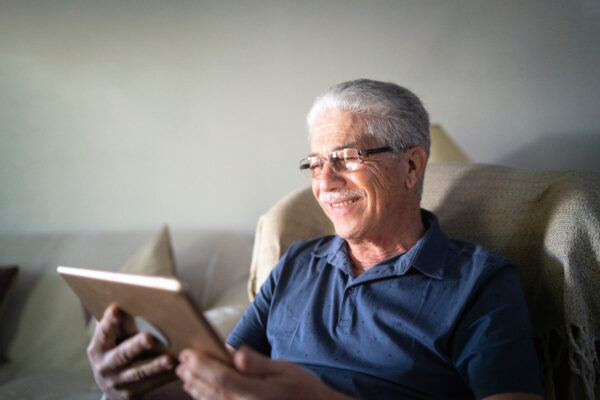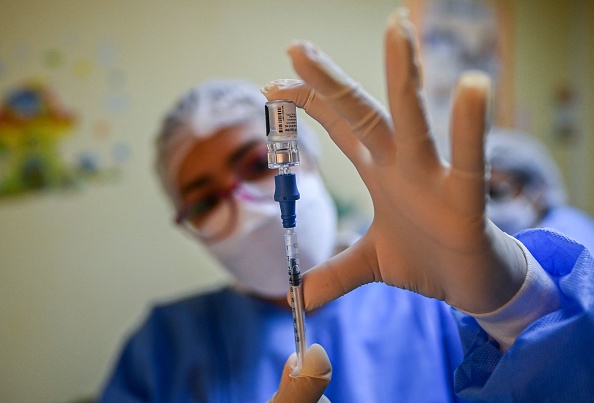The innovation institute run by the University of North Carolina at Chapel Hill teamed up with Amazon Web Services on Wednesday to create a venture studio to turn the university’s digital health research concepts into full-fledged startups. AWS’ platform beat out the other major cloud providers because it was “the most entrepreneurial,” according to Bob Dieterle, the venture studio’s managing director.
Dieterle helped create the venture studio because he noticed something important: despite the fact that universities produce plenty of valuable digital health research, they often fail to commercialize digital health products in the form of modern app technology.
Universities need a better pipeline model to quickly turn research into cloud-based digital health apps, he said in an interview.
The collaboration will support 25 concept development projects over three years. Refining the venture concept and validating technology may take longer than three years for some projects, so the collaboration has a goal of launching 10 startups during that time period, Dieterle said in an interview.
UNC and AWS are selecting projects that improve healthcare access, patient outcomes and the patient and provider experience. UNC researchers whose projects are selected will receive guidance from AWS software developers who specialize in cybersecurity, computing, biomedical research, and healthcare machine learning.
There are five types of projects the collaboration is looking to support: platforms to help providers better run their enterprises, platforms to help clinicians and clinical support staff, products that store and transmit clinical information to guide care, products that aid in the diagnosis or monitoring of patients, and medical interventions or therapies.
UNC researchers will collaborate with experts from AWS at UNC-Chapel Hill’s health research labs. They can use the research labs’ software building platform to build their concepts into production-ready models to run on AWS.
When choosing a cloud partner for this venture studio, UNC looked at other major cloud providers, including Google, Microsoft and Oracle, according to Dieterle. He said UNC went with AWS because it was the company that demonstrated the most commitment to building a new type of cloud-based pipeline to commercialize more digital health research from universities.
“We need a new model than what is currently being done,” Dieterle said. “If you look at the big tech companies, they’re very siloed. They have a public sector team, and all they care about is selling to a university, for example. Then they have a startups team. These teams don’t necessarily work together. And then the startups team will wait for a university startup to be spun out, and then they engage with them. And they have innovation programs — and these programs, disparately, really don’t work. We need to identify a pipeline.”
Under this pipeline model, researchers can access cloud-based software and data science tools to help them validate their algorithms sooner — and hopefully get to commercialization sooner.
AWS was the cloud provider who demonstrated the most enthusiasm about this pipeline model, according to Dieterle. He said AWS brought together its public sector team, startup team and research team together into one and worked with UNC to create a single concept development process.
“I tried to do this with the others, and they weren’t really very interested in doing that. So that’s how we settled on Amazon,” Dieterle said.
Eight of the collaboration’s 25 planned projects have already kicked off. As startups begin to be launched out of the venture studio, UNC will share upside with them. For example, UNC will financially benefit when startups license the technology that was developed at the university. UNC is also becoming investors in these companies and getting on their capital tables, according to Dieterle.
Photo: Eva Almqvist, Getty Images
Medical software company Cerner must head to trial for a jury to decide whether its software contained design defects that caused brain damage to a 25-year-old who was undergoing surgery to remove his gallbladder.
In a 2-1 decision, the Fourth Circuit said that the lower court, the Eastern District of Virginia, erred when it sided with Cerner and granted the company summary judgement.
“On the record before us, a jury reasonably could conclude that Cerner’s software contained two design defects that did not comply with industry standards or satisfy reasonable consumer expectations,” Senior Circuit Judge Barbara Milano Keenan stated in the opinion published Tuesday in a decision from the Fourth Circuit Court of Appeals.
Cerner, based in Arlington, Virgina, develops and sells a software system that hospital staff use to enter medical orders for patient care.
The case started when Ruby Lowe, grandmother of patient Michael Taylor, filed a lawsuit against Cerner in 2019 on behalf of her grandson. In seeking $50 million in damages, Lowe alleged that there were two design defects in Cerner’s software and that the company failed to warn users of those defects.
As described in the opinion, Lowe maintains that those alleged defects affected the doctor’s orders. The doctor’s orders were supposed to show that pulse oximetry should start immediately after the surgery but instead showed to start pulse oximetry at 10:00 a.m. the day after Taylor’s surgery.
Lowe contends that when the doctor — Alexandria Booth — performed surgery on Taylor at Virginia Hospital Center, she put in an order for him to receive continuous pulse oximetry to measure the oxygen levels in his blood. A pulse oximeter will send an alarm to alert hospital staff when a patient’s oxygen drops below a certain level so the staff can wake the patient.
However, Taylor’s oxygen levels were not monitored overnight and he suffered from hypoxia, or a lack of oxygen to his brain, causing damage. As a result, Taylor can no longer walk, bathe, or use the bathroom by himself.
“The parties do not dispute that if Taylor’s oxygen level had been monitored continuously, his resulting hypoxia and brain damage would not have occurred,” Keenan wrote in the opinion.
The question is who is at fault. And the Court of Appeals believes it’s possible to point the finger at Cerner.
In his dissent, Judge James Harvie Wilkinson wrote that because Taylor’s grandmother already reached a settlement with the hospital where the procedure was performed — Virginia Hospital Center — and with the doctor’s employer, the case seems to be about money only.
“There is one reason, and one reason only, that the manufacturer is a defendant in this suit. It has a deep pocket,” Wilkinson wrote.
He said that Lowe has failed to show that Cerner’s software was a probable cause for the brain damage Taylor suffered. He says that hospital staff are to blame for the tragedy that occurred.
Lawyers for Lowe and for Cerner did not immediately respond to requests for comment.
Photo: AndreyPopov, Getty Images
To address challenges during the Covid-19 pandemic, state and federal governments provided temporary waivers and flexibilities to make telehealth more available for consumers. Now, Americans want the government to make these provisions permanent, a new survey shows.
The survey was published Thursday by advocacy group America’s Health Insurance Plans (AHIP). It was fielded in October by NORC at the University of Chicago and included a nationally representative sample of 1,000 adults, of which 498 were commercially insured.
AHIP’s survey found that 73% of commercially-insured telehealth users think that “Congress should make permanent the provisions that allowed for coverage of telehealth services before paying their full deductible.”
Because of these findings, “health insurance providers encourage policymakers at the federal and state levels to make telehealth design flexibilities permanent to allow for the continued convenience, access, and value they provide for Americans,” the advocacy organization stated in a news release.
The survey also discovered:
Four in 10 of the commercially insured respondents said they had used telehealth in the last year. Of this group, more than half used telehealth between 2 to 5 times in the past year.
Nearly 70% of commercially-insured telehealth users said they used telehealth instead of in-person services in the last year because of convenience.
Almost 4 in 5 commercially-insured telehealth users said telehealth helped them receive care when they needed it.
Another 85% said there is an “adequate” number of providers available through telehealth to meet their health needs.
Women with commercial insurance were 1.6 times more likely than men to use telehealth services. Women were also four times more likely than men to use telehealth due to a lack of childcare or eldercare.
Those with low to middle incomes use telehealth slightly more than those with higher income. About 40% of those earning $30,000-60,000 annually and 46% of those earning $60,000-100,000 annually use telehealth, compared to 38% of those earning more than $100,000.
“Patients and providers accept — and often prefer — digital technologies as an essential part of healthcare delivery,” Jeanette Thornton, executive vice president of policy and strategy at AHIP, said in the news release. “Telehealth can be just as effective as in-person care for many conditions and allows patients to receive more services ‘where they are.’ That’s why health insurance providers are committed to strengthening and improving both access and use for the millions of Americans who use telehealth for their health care needs.”
Photo: Alisa Zahoruiko, Getty Images
UpStream — a company that provides care coordination technology and services for physicians enrolled in value-based care models — raised $140 million in Series B financing on Thursday.
The round brings the Greensboro, N.C.-based company’s total funding to nearly $185 million to date. It was co-led by investment firms Coatue and Dragoneer, with participation from Avidity Partners, Define Ventures and Mubadala.
UpStream was founded in 2018 by pharmacist and entrepreneur Fergus Hoban.
“[Hoban] was deeply cognizant of the challenges of the broken healthcare system — mainly the fact that patients who were living with chronic conditions and medically complex conditions really got the shortest end of the stick in primary care practices. They were shuffled between specialists in primary care. And due to their medical complexity, they did not fit into the conventional time slot of a 15 to 20 minute primary care visit,” UpStream CEO Sanjay Doddamani said in an interview.
UpStream’s mission is to address the fact that patients with chronic conditions often do not receive an appropriate level of care — a reality that often sends them to emergency departments and hospitals. Many of these admissions could be avoided if patients received the right care earlier, Doddamani said.
To solve this problem, UpStream provides primary care practices with AI-based technology designed to anticipate patient needs and coordinate care for patients living with chronic conditions. The company also deploys pharmacist-led care teams into primary care practices. These teams are meant to bring all of a patient’s challenges “under one umbrella,” from managing multiple prescriptions to coordinating transportation to appointments, he said.
These pharmacist-led care teams are meant to make patients feel more comfortable and less rushed in the U.S. healthcare system. Doddamani claimed that this approach involving pharmacists is one of the factors that differentiates UpStream from its competitors, such as Oak Street Health, Agilon Health and Privia Health.
Another factor is the fact that UpStream takes on full financial risk with payers to enable physicians to deliver value-based care to seniors, who are often the most complex and expensive patients to care for, Doddamani pointed out.
The company doesn’t charge providers to use its services. While it gets to share in savings, UpStream is also accountable for some of the loss if spending goes beyond the benchmark. The company has negotiated rates with Medicare programs and takes on both upside and downside risk — but physicians “only see the upside” because they get paid by UpStream no matter what, according to Doddamani.
“We have to put up capital reserves to participate in these models,” he said. “And then based on savings, we get paid. Our physicians also get paid based on savings. But the way we’ve constructed our model, our physicians don’t wait to get paid.”
UpStream works with physicians who provide care to seniors on Medicare under full-risk, value-based arrangements. Some of these physicians are independent, and others are attached to a larger network or healthcare system.
The company has partnered with physician groups in North Carolina, Virginia and South Carolina.
For next year, UpStream has announced new partnerships with Community Care Physician Network in North Carolina, Tidewater Medical Group in Virginia, Primary Care Associates in South Carolina, and Medical University of South Carolina Health Alliance.
“We have enabled the primary care physician to enter into a domain of full financial risk,” Doddamani said. “They can have maximum opportunity for that boat financially — but also more importantly, for resource-rich environments to be able to deliver better care for their older, sicker patients right in the existing primary care infrastructure. How can they do that? Because we put in the vital resources that they need — not just the technology, but also the people.”
Directly embedding a pharmacist in primary care offices to manage prescriptions is a key way UpStream does this. Providing patients with home-based support, such as field nurses and a medical support concierge, is another way.
UpStream’s internal data shows that when patients are supported by their services, their cost of care ends up decreasing by an average of 20%, according to Doddamani. This mostly comes from annual reductions in hospitalizations and emergency department visits, he said.
“We don’t stand in the way of patients or act as a barrier to their aspirations for something like elective surgeries when appropriate — it is really about reducing the avoidable suffering that patients are confronting by having to repeatedly go into the hospital for one of their underlying chronic conditions,” Doddamani said.
Photo: Doug Burke Photography
Data released Wednesday by Blue Cross Blue Shield Massachusetts revealed that mental health visits among its members have increased 100% since 2019. In response, the payer is upgrading its services.
In the third quarter of 2022, BCBS Massachusetts’ members had about 8 million behavioral health visits, compared to about 4 million in 2019. The insurer has expanded its provider network by almost 46% to about 18,000 clinicians in the last five years to meet this demand. To further meet members’ needs, the payer is expanding its primary mental health provider network by contracting with Talkiatry, which provides virtual psychiatric therapy, in-person therapy and medication management, the company recently announced.
Aside from working with Talkiatry, BCBS Massachusetts is also targeting specific conditions and populations by contracting with two specialty mental health provider groups: And Still We Rise and DynamiCare. The former is a provider for marginalized communities, while the latter is a digital therapeutics and coaching company for those battling addiction.
Although mental health was a challenge before the pandemic, Covid-19 escalated the issue, said Dr. Greg Harris, senior medical director of behavioral health at BCBS Massachusetts. It is for this reason that the insurer is ramping up its mental health services.
“We were seeing year over year increases prior to the pandemic and the pace of the increases have gone up dramatically,” Harris said in an interview.
BCBS Massachusetts chose Talkiatry because of its ability to provide support for a variety of ages, needs and preferences, Harris said. The New York City-based company joins several other primary mental health groups in the payers’ network, including Thriveworks, Headway, Refresh Mental Health and Valera Health.
In addition to expanding its primary mental health services, the insurer knew it needed to combat health disparities as well, Harris said. That’s why it chose to work with And Still We Rise and DynamiCare.
“And Still We Rise focuses on diverse populations, that’s their sub-specialty and that’s why we brought that group in,” Harris stated. “DynamiCare we brought in because they focus on a broad range of substance use conditions: alcohol, drugs and tobacco. And they provide a novel treatment model that we couldn’t really get in any other way.”
It already contracts with NOCD for OCD treatment, Forge Health for addiction and trauma support, Aware Recovery Care for addiction treatment and Brightline for family mental health support.
Looking ahead, Harris said BCBS Massachusetts will add additional virtual mental health groups and tackle other specialty areas, such as eating disorders and autism.
“These two areas, autism and eating disorders, are areas of high clinical complexity and sometimes difficulty in finding the right care in real time,” Harris said. “So that’s why those are two priority areas that we’ve really made a commitment to try and solve as soon as possible.”
Photo: SIphotography, Getty Images
Older adults are projected to outnumber kids for the first time in U.S. history by 2034. As our population ages, preparations must be made across industries, fields of study and governments to address its evolving needs, including in clinical trials that set the standards for efficacy and safety of new treatments, especially in cancer. Ageism is an often-overlooked health inequity widely prevalent in cancer clinical research. Despite the fact that cancer is a disease of aging (42% of people with cancer are at least 70 years old), studies show that older patients comprise only 24% of participants in cancer trials.
Equitable representation in trials improves our understanding of a drug’s benefit-risk profile for patients who will ultimately receive treatment. This is especially true for cancer drugs, because differences may exist between younger and older adult patients in drug response and toxicity due to age-related physiologic changes. Today, almost everything we know about cancer therapeutics is based on trials conducted in younger patients, who also have fewer functional or cognitive impairments and/or co-morbidities than older patients.
Recognizing the urgency of addressing this issue, the U.S. Food and Drug Administration (FDA) issued new guidance in March 2022 that recommended “including an adequate representation of older adults in cancer clinical trials.” It also emphasized “the particular importance of including adults over the age of 75,” who represent a growing segment of the cancer patient population and a growing proportion of the global population.
The roots of this problem are deeply embedded in the systemic clinical trial infrastructure, regulatory requirements, and standard practices, all of which will need to be overhauled in the coming years as the population ages. In the meantime, those of us involved in cancer drug development, research, treatment, patient care and advocacy should evaluate which structural barriers can be navigated around to increase participation of older patients in clinical trials at present. Here are four actions we can take now:
Educate and engage patients and referring providers
According to the National Institutes of Health, a principal challenge of recruiting participants is the lack of awareness and education about clinical trials, availability and how to participate. In a nationwide survey, 80% of patients with cancer did not consider the possibility of participating in a treatment clinical trial because they were unaware that this was an option. This lack of awareness is anticipated to exacerbate in older adults as use of digital technology pervades clinical research and recruitment.
The cancer community must step up its efforts to educate and engage patients, site coordinators, patient advocates and caregivers about clinical trial protocols and participation. Educating referring physicians is an especially important, yet overlooked, way to increase enrollment of older adults in cancer clinical trials, as studies have shown that lack of primary care provider support is a key deterrent to clinical trial participation.
Re-evaluate eligibility criteria
The protocols for many cancer trials explicitly exclude a significant portion of older and frail adults because of their medical histories and co-morbidities. In a recent systemic review, researchers identified stringent eligibility criteria as a major barrier to older adult access to available trials.
Eligibility criteria should be re-evaluated to ensure the reason for excluding these patients is based on strong clinical or scientific evidence. When creating these criteria, researchers should consider how they align with the physical and cognitive capabilities and medical conditions of those most likely to take the approved drugs. According to the new FDA guidance, trial sponsors should consider getting input on trial design, trial conduct and recruitment strategies from geriatricians, geriatric oncologists, and social and behavioral scientists. A study on barriers to participation recommended that “Protocol designs need to stratify for age and be less restrictive with respect to exclusions on functional status, comorbidity and previous cancers.”
Bring research to the trial participants
Even when older patients do meet enrollment criteria, many do not want to participate in clinical trials because of transportation issues, time demands, and cost constraints. An obvious solution emerged during the Covid-19 pandemic – using technology to bring healthcare to the patient. “Telehealth” has become a new norm and the popularity of decentralized clinical trials skyrocketed after Covid-19.
The FDA Oncology Center of Excellence (OCE) supports the decentralization of clinical trials through the remote collection of trial data outside of standard in-person trial sites. Such methods can include: electronic informed consent, delivery of investigational product to the home, virtual clinic visits in patients’ homes for monitoring and data collection, and obtaining laboratory or imaging assessments locally. Decentralizing burdensome aspects of trials will remove obstacles to patient enrollment and participation, while providing healthcare providers real-time data.
Design trials that focus solely on geriatric patients
Perhaps the most effective approach to increase enrollment of older adults is to conduct trials specifically for older adults. Studies confined to older patients can address questions of particular interest to older adults (e.g., preservation of function) and increase our knowledge of tumor biology and the effect of comorbid conditions in the geriatric oncology patient population.
For example, because age is the major risk factor for breast cancer, one study for women with early-stage breast cancer who were 65 years of age or older found that standard adjuvant chemotherapy was superior to a monochemotherapy. Other studies are underway to assess the efficacy and tolerability of new drugs 1) in unfit and frail participants 80 years and older with previously untreated diffuse large B-cell lymphoma, and, 2) as an adjuvant alternative to chemotherapy in patients with high risk breast cancer 70 years and older.
People are living longer and this growing patient population needs innovative treatments tailored to the needs of aging bodies, which is why clinical research must include elderly patients. A Cancer and Aging Research Group conference report says it well: “Older age alone should not be a contraindication to clinical trial enrollment.” While the barriers to inclusivity are complex and multifaceted, it’s long past time to tear them down and develop new approaches to research that will lead to evidence-based care for geriatric patients with cancer.
Photo: FG Trade, Getty Images
More than 500 million people on the planet have chronic lung disease — all eager for better therapies. Unfortunately, the wait for novel treatment is a long and expensive one — it takes 14 years and more than $1 billion, with a failure rate of 95%, to get a single drug from research labs to pharmacies.
Many of the issues that contribute to these high-cost failures and delays in clinical trials have something in common: poor data. Here are two examples:
Weak endpoints – Common tests used to assess treatment response, such as the six-minute walk test, are often indirect measures of lung health, are insensitive, or both.
Poor data quality – Data quality issues can occur in data acquisition, transcription, storage, and more. To measure the impact of a drug, it is critical that the collection of data from time point to time point is consistent and comparable.
Because of weak endpoints and poor data quality, clinical trials require large population cohorts to show a statistically significant therapy impact. This drives high cost and long timelines.
Good news
There is good news for those 500 million patients with lung disease. We are in the midst of a lung intelligence revolution that is vastly improving the efficiency of clinical trials by addressing the underlying issue of poor data. The combination of rich imaging data, called an “imaging biobank,” with advances in artificial intelligence (AI) is a powerful tandem.
With lung intelligence, trials don’t need to rely on weak endpoints. Sponsors are increasingly leveraging imaging biomarkers that deliver direct and precise measures of a therapy’s impact on lung structure and function. Now that sponsors can measure sub-millimeter changes to airway walls, for example, the impact of a therapy can be seen much quicker and with fewer subjects compared to conventional measures (e.g. exacerbations, death, or a six-minute walk test).
While precision imaging biomarkers are incredibly powerful, there has been a hurdle for trial sites to overcome. Collecting high resolution, consistent imaging data can be more challenging than administering conventional tests such as patient surveys. For example, CT scanners must be calibrated at regular intervals, patients must be coached on breath holds, and other elements of a trial protocol must be followed carefully to ensure high quality data.
Cloud services, AI, and refined data: A powerful trio
Across life sciences and healthcare, the ability to capture, share and analyze data in the cloud has transformed drug discovery and clinical trials. With that cloud infrastructure, the transformative value of lung intelligence truly shines.
Cloud-based portals now orchestrate imaging operations for clinical trial sites, allowing staff to easily overcome the hurdle of executing precision clinical trial imaging. For example:
AI-powered services perform quality control checks and can intervene instantly to prevent poor data from entering the system.
Reminders are issued to sites at appropriate intervals for scanner calibration, with step-by-step guidance.
Staff training is conducted through portal-based eLearning modules, with certification status maintained centrally.
Data management, including auto-anonymization, secure exchange, and data organization is now managed effortlessly and centrally by cloud technologies.
Imaging biobanks and operational data is available in the cloud for high-value analysis, such as retrospective analyses that could identify candidates for future trials.
Sponsors have real-time trial business intelligence dashboards to monitor the health of their trial sites, data quality, and overall trial operations.
The combination of cloud and AI/imaging-related biomarkers has dramatically reduced the friction historically caused by sponsors introducing imaging endpoints to a trial. Cloud services put AI-generated biomarkers just a few clicks away. Now, for trial sponsors who want to capitalize on the significant benefits of bringing imaging into their respiratory clinical trial, operational complexity for sites is no longer a time or cost barrier. Furthermore, sponsors can be confident in the quality of the data that will be collected by cloud-enabled sites.
Decentralized trial imaging
Now that cloud portal technologies are removing friction from imaging-based clinical trials, an interesting beneficiary has emerged: independent imaging centers. These centers traditionally have not participated in clinical trial imaging, largely due to the complexity that was involved. As a result, trials have been centralized, often at large academic centers. With cloud-based trial platforms enabling a broader set of sites, we are seeing radiology imaging groups embrace clinical trials, which expands access to patients and diversifies trial populations. The concept of decentralized clinical trials—trials that allow for data collection outside of large medical centers—is now becoming a reality even for trials that involve advanced imaging.
A bright future
Thanks to the convergence of cloud technologies, AI, and refined lung data, we are in a new era for those with chronic lung disease. In this new world, lung intelligence provides fast, precision measures of treatment efficacy so new drugs can blaze through the trial pipeline. Trial sites can now conduct precision imaging with ease, collecting pristine data for sponsors. Imaging data can be collected in hundreds of locations in both urban and rural areas to foster diverse trial cohorts.
The biggest winners in this new era are patients with chronic lung diseases. Clinical trials are more accessible and new life-extending therapies are finding their way to pharmacies faster.
After seeing how quickly the healthcare community could introduce new vaccines to market for Covid-19, there’s a renewed sense of enthusiasm for innovations that accelerate timelines. This enthusiasm, combined with lung intelligence, gives hope for a bright future of fast, efficient, clinical trials.
Photo credit: Jackie Niam, Getty Images
In a webinar sponsored by flipMD, from GoodRx, panelists discussed how the company is helping healthcare businesses optimize product development, marketing and go-to-market strategy, user adoption and more – all through collaboration with practicing physicians.
Panelist Dr. Gregory Hanson, co-founder of flipMD, shared how he developed the idea for flipMD when he and his wife lived in South Philadelphia during his residency when he was moonlighting as a consultant to make ends meet. That’s when he became aware of the lack of a platform specific to physicians to work with healthcare innovation companies looking for medical expertise.
“The idea for flipMD really came about from figuring out that it was a pretty big challenge for companies to find specific physicians, whether a practicing neurosurgeon to a nephrologist. It was just to make it easier for companies to be able to work with any type of physician from residents and fellows through early mid-career, late stage attending physicians or even retired physicians. That was the initial impetus and that’s why we built the company.”
The Covid-19 pandemic – coupled with ongoing healthcare industry challenges such as staff resources, hospital consolidation, and moral injury – has prompted a trend in physicians seeking alternate career solutions. At the same time, healthcare startup and growth stage companies oftentimes look to engage medical talent to provide useful insights to maximize and validate their work. Together, companies and physicians can mutually benefit each other: companies can hire physicians who possess the right expertise for their project, while physicians have the flexibility to pursue new opportunities outside of their clinical work.
Emergency Medicine physician, Dr. Caitlin McCord Delaney, assistant professor of Clinical Emergency Medicine with Georgetown University, described this demand for a fuller career from physicians and explained that they are also motivated by wanting to share their perspective on what’s working and what’s not in the health system.
“I’ve really seen a huge uptick in people’s interests in health tech and in new products and in, ‘What can we do to actually fix our healthcare system?’ There’s a huge demand right now from physicians who are looking for these different types of roles, they’re wanting to learn more about what’s out there,” Delaney said. “One of the things that I think is really significant about a platform like [flipMD] is that it allows you to cross-pollinate those different sectors. It’s good to have people who know something about both sides of it and to have the ability to work with those who have that different perspective.”
Another facet of the webinar discussion was the job of helping healthcare entrepreneurs find a suitable physician match for their needs. Dr. Jonathan Larson, president of Hey Doctor with GoodRx Care Provider Network, said it can be a monumental effort for companies to perform that task on their own.
“It’s great to connect to physicians, but we’re not all made alike. Our training and education and experiences are diverse. And so really finding that right fit so you don’t spend a bunch of money on somebody that maybe can talk a good game, but when it comes to bringing substantive information that really helps you move forward, they may just not be the right fit.”
And not finding the right fit can be costly. Among some of the interesting facts discussed was that the marketing budget for seven of the 10 largest pharmaceutical companies eclipses their R&D spend many times over. Moreover, in the medtech industry, the average cost to bring a product from concept to market is $31 million.
“Every company is addressing a need in healthcare and trying to create a solution that will be adopted by the majority, but it’s led to a very crowded marketplace. And so, it’s most important that we spend time thinking about how to differentiate and stand out in this market,” noted Lauren Hanson, founder and Head of Product with flipMD from GoodRx and the webinar moderator. “At the end of the day, if patients and physicians aren’t using your product, then even if it’s the best, you’re not making that big of an impact.”
To download and watch the webinar to learn more about how flipMD is working with healthcare companies to help match them with clinician expertise, please fill out the form below.
OVID-19 continues to haunt some patients, with many suffering from so-called long COVID. Women and those with high body mass index (BMI) may be at higher risk for the condition, a new study has found.For their study, published Wednesday on PLOS Global Public Health, a team of researchers conducted a survey to “characterize the burden and predictors” for long COVID.Long COVID, also known as post-COVID syndrome, is the condition wherein the symptoms patients develop during or after a COVID-19 infection persist for over 12 weeks after being diagnosed with it. Symptoms may range from coughing, fatigue and breathlessness to brain fog, tinnitus and chest pain.”Ongoing symptomatic COVID-19 or post-COVID-19 syndrome is estimated to be adversely affecting the day-to-day activities of 836,000 people in the United Kingdom according to the ONS (Office for National Statistics, UK) report, with 244,000 saying their ability to undertake day-to-day activities had been ‘limited a lot,'” the researchers wrote.
To shed further light on the condition and potentially inform healthcare services, the researchers surveyed people in Norfolk, East England U.K. who were diagnosed with COVID-19 in 2020. In total, some 1,487 people participated in the survey, wherein they answered queries about pre- and post-COVID conditions such as breathlessness, loss of taste or smell, and their use of healthcare services related to long COVID.”We wanted to find out what factors might make people more or less susceptible to developing long COVID,” one of the study authors, Vassilios Vassiliou of the University of East Anglia’s (UEA) Norwich Medical School, said in the university’s news release.Of all the participants, 774, or 52.1% experienced long COVID. What’s interesting, however, is that more women had the symptoms compared to men, with the male sex appearing to be “protective of post-COVID symptoms” compared to the female sex.Having a higher BMI was also associated with higher risks of developing long COVID.”It was found that female sex and high BMI are associated with higher likelihood of developing post-COVID19 syndrome,” the researchers wrote. “Those two factors have a significant predictive value in the use of further health services among those diagnosed with post-COVID19 syndrome.”The results, they say, are in line with another previous research in England, wherein females were also found to have higher long COVID rates than males.This sheds further light on the condition that many continue to suffer from. According to the U.S. Centers for Disease Control and Prevention (CDC), for instance, long COVID has also been more often observed in some people such as those who had severe COVID-19, while those who weren’t vaccinated for COVID-19 may also face higher risks for it.The impact of long COVID may go beyond just the patients, too, as an expert pointed out that it may also have a $3.7 trillion impact on the U.S. economy. Hence, the results of this study provide valuable information about long COVID and the people who are most likely to suffer from it.”We hope that our work will help policymakers plan local services and also inform the wider public of the scale of the long COVID pandemic,” Vassiliou said, as per UEA.”Our academic colleagues at the University of East Anglia have really helped local health and care organizations to identify local patients at risk of long COVID, helping us to do all we can to support them on their recovery journey,” another study author, Mark Lim, added.
An insightful study analyzing what contributes to the sharpness of mind in old age has found evolutionary hints.The study, which was published in the peer-reviewed Chinese journal Science Bulletin, found that more developed frontal lobes were associated with sharp minds in some old people. The reason behind this occurrence may be attributed to natural selection in human evolution.“Our team initiated the Beijing Ageing Brain Rejuvenation Initiative in 2008, which focused on elderly people with cognitive impairment because they needed more attention. But during our community-based research, we found there was a group of elderly people who aged more slowly and had a higher quality of life,” Chen Yaojing, study corresponding author and a researcher at Beijing Normal University, said, reported South China Morning Post. “We want to learn from them and find out ways to keep our brain in a healthier state.”It was found during the study that people who had successful cognitive aging (SCA) had a better preserved frontal region of the brain. Meanwhile, people with mild cognitive impairment (MCI) exhibited structural deterioration in the temporal region of the brain.
The authors put forward a “frontal preservation, temporal impairment (FPTI)” hypothesis to provide an explanation for the differences in individuals’ cognitive aging.The frontal lobes are associated with cognitive functions, such as decision-making, problem-solving, and attention. Interestingly, the frontal lobes are one of the main features that separate human beings and animals. The frontal lobes are proportionally larger in humans than in other species of animals.Chen said the human frontal lobe was the most recent one to evolve and it exhibited age-related decline faster than other abilities.“There’s a theory called ‘last in, first out’. The newest part in evolution will decline first because human beings tend to save their survival abilities to the end,” Chen said. “So, for most elderly people, the functions of their frontal lobes decline early. But for people with successful cognitive aging, their frontal lobes are preserved well.”The temporal lobes are responsible for processing auditory information and preserving memory. Structural abnormalities in this region have been associated with pathological cognitive aging, according to researchers.Three groups of older adults aged between 70 and 88 were recruited for the study. These included 64 successful cognitive aging individuals, 68 mild cognitive impairment patients, and 66 cognitively normal controls.For the study, Chen and her colleagues analyzed gray matter volume, gray matter networks, and white matter network characteristics of the three groups.Compared to the other two groups, the SCA group performed better on all three parameters.“If our hypothesis is proven true, in the future we can develop the frontal lobes or slow the aging of temporal lobes,” Chen concluded. “This is a multidisciplinary effort.”









